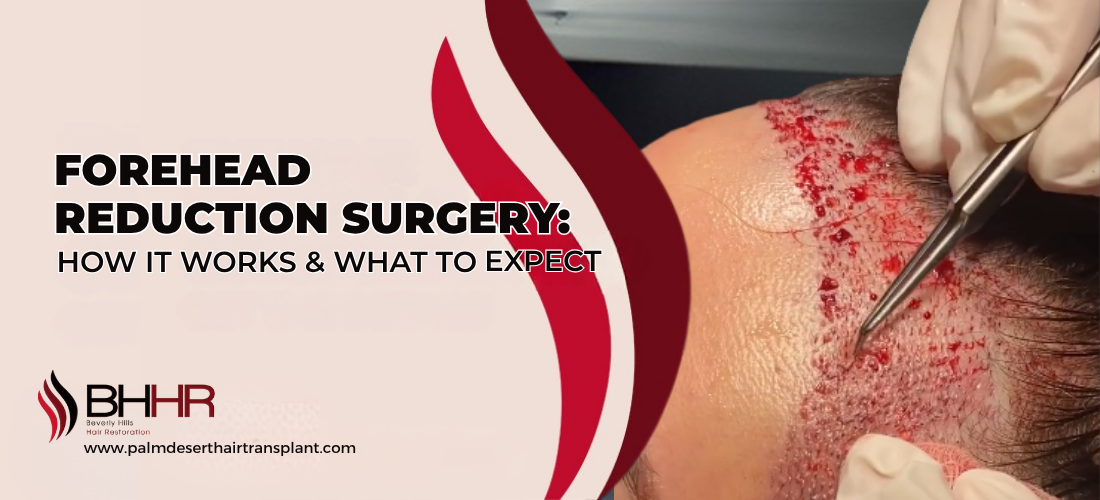Forehead Reduction Surgery: How It Works & What to Expect
Home / Hairline Lowering / Forehead Reduction Surgery: How It Works & What to Expect
Updated On : December 12, 2025 | Category : Hairline Lowering | Author: Beverly Hills Hair Restoration Team

Feeling insecure about a high or prominent forehead? You’re not alone—and there’s a solution. Forehead reduction surgery is a safe, effective and advanced procedure designed to reduce forehead size and achieve a more balanced facial appearance. Whether you're looking to improve proportions or restore confidence, this surgery offers noticeable, long-lasting results. But before leaping, it's essential to understand how the procedure works, what recovery involves, and who it’s right for.
In this blog, we’ll cover everything you need to know—from the surgical process and potential risks to recovery timelines and expected results. If you're curious about transforming your look with forehead reduction surgery, this comprehensive guide will help you make an informed decision. Let’s explore what to expect every step of the way at our hair transplant clinic.
What Is Forehead Reduction Surgery?
Forehead reduction surgery lowers the hairline and reduces the vertical height of the head, creating a more balanced facial appearance. Traditionally, this was achieved through scalp advancement, an invasive method that involves removing a strip of skin and pulling the hairline forward.
Today, a more advanced approach—hairline hair transplant—offers similar results with less trauma. Hairs are transplanted from a donor area to a newly designed hairline, allowing for minimal scarring, greater design flexibility, and a more natural outcome.
This modern technique is now the preferred option for those seeking a less invasive, highly customizable way to reshape the upper face.
How Does Forehead Reduction Surgery Work?
Forehead reduction through hair transplant is a step-by-step process involving hairline design, graft placement, and recovery—a method we follow at Beverly Hills Hair Restoration to ensure precise, natural results.
-
Step 1: Consultation and Initial Assessment
The process begins with a consultation, where our doctor evaluates your hairline, scalp condition, and donor area. Together, you’ll discuss your aesthetic goals and design a hairline that fits your face shape and desired forehead height.
-
Step 2: Pre-Surgery Preparation
Before the procedure, you’ll receive personalized instructions. These may include temporary medication changes, scalp care, and avoiding certain substances like alcohol or blood thinners to ensure optimal healing.
-
Step 3: The Surgical Procedure
During the procedure, advanced methods like FUE or FUT are used to extract healthy hair follicles from the donor area. These grafts are then strategically implanted along a newly designed hairline, allowing for a natural, lowered appearance with minimal scarring and a highly customized, patient-specific result.
-
Step 4: Post-Surgery Care and Recovery
Once your forehead reduction surgery is done, taking care of yourself is key. Proper rest, avoid strenuous activities, and gently clean the area. Swelling will ease over time, and soon, you’ll start to notice the difference.
Ideal Candidates for Hairline Lowering Surgery
Hairline lowering can be a suitable option for individuals looking to reduce the appearance of a high forehead without undergoing invasive surgery. Ideal candidates typically include:
-
Individuals with a high or large forehead who desire facial symmetry
-
Individuals in good health with no major medical issues and non-smokers, since smoking can interfere with the healing process.
-
People with realistic expectations about the outcome of the surgery those with a stable mental health condition, are prepared for post-surgery recovery
-
Individuals who are dissatisfied with their appearance and looking for a permanent solution to forehead size
If you think forehead reduction could improve your appearance, consult with a skilled surgeon to determine if you're a suitable candidate.
Why Choose Hair Transplant Over Scalp Surgery?
|
Feature |
Hair Transplant (FUE/FUT) |
Traditional Forehead Reduction Surgery |
|
Technique |
Grafts placed to build a lower hairline |
Forehead skin is removed; scalp is advanced |
|
Scarring |
Minimal (often undetectable with FUE) |
Linear scar along the hairline |
|
Recovery Time |
Shorter (7–10 days) |
Longer (2–3 weeks) |
|
Hairline Design |
Fully customizable in shape and density |
Limited flexibility in design |
|
Suitability |
Ideal for gradual hairline lowering |
Better for large forehead height reductions |
Final Thoughts on Forehead Reduction Surgery
Forehead reduction surgery provides a powerful solution for individuals seeking to enhance facial harmony and boost their self-confidence. Thanks to modern techniques like hairline lowering through precision hair transplantation, patients can now achieve natural, long-lasting results with minimal invasiveness and downtime. The key lies in selecting the right expert who understands both artistry and technique.
At Beverly Hills Hair Restoration in Palm Desert, advanced technology meets world-class expertise to deliver highly customized, natural-looking outcomes. With a guide on patient comfort and aesthetic precision, this trusted clinic helps individuals reshape their appearance—and their confidence—with care.
Ready for a change? Our hair transplant specialists in Palm Desert are here to help you create a more balanced, natural look. Call at 760.501.0080 to schedule your free consultation today!
FAQs About Forehead Reduction Surgery
How long does the recovery take?
Recovery typically takes about 2-3 weeks, with initial healing occurring within the first week, followed by the subsiding of swelling and bruising. It may take between three to six months for the scalp to fully heal and the final results to become visible.
Is forehead reduction surgery painful?
Most patients experience minimal discomfort during the method, which is typically managed with anaesthesia. Post-surgery pain can usually be controlled with prescribed pain medication, and swelling subsides within a few days.
Will there be visible scarring after surgery?
Scarring is minimal and usually well-hidden along the hairline, making it nearly invisible. With proper care, scarring typically isn't noticeable to others.
What should I avoid during recovery?
To ensure proper healing, avoid strenuous exercise, lifting heavy objects, and exposure to direct sunlight during the recovery period to prevent complications and provide the best results.
